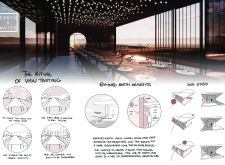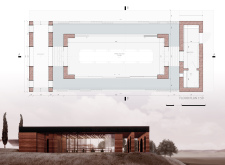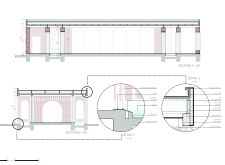5 key facts about this project
Functionally, the venue serves as a dedicated space for wine tasting, education, and social interaction. Its design facilitates a seamless flow between indoor and outdoor environments, allowing visitors to appreciate the views and the landscape that surrounds the site. The layout includes a spacious tasting room, areas for small group gatherings, and elements that encourage communal activities, reflecting a contemporary understanding of social spaces in architectural design.
Key aspects of the design include the predominant use of rammed earth, which not only reinforces the structure but also contributes to its thermal performance and acoustic qualities. This material choice signals a commitment to sustainability, offering advantages such as regulating indoor temperatures while minimizing energy consumption. Large glass panels are integrated into the design to enhance visual connectivity with the landscape. This transparency allows natural light to flood the interiors, creating an inviting atmosphere that resonates with the tranquil surroundings.
The architectural plans emphasize a carefully considered relationship between the building and its environment. The entrance is thoughtfully designed to lead visitors through a journey, gradually revealing the core spaces of the venue. The organization of the floor plan places emphasis on the central tasting area, strategically aligning it with the picturesque views. This spatial arrangement encourages guests to not only engage with the wine but also to immerse themselves in the natural beauty that surrounds them.
Unique design approaches are evident throughout the project. For instance, the inclusion of ventilation systems and sun shading devices demonstrates a nuanced understanding of climate-responsive architecture. These features are integrated into the structural design, optimizing airflow and light management while avoiding the imposition of mechanical systems that might disrupt the aesthetic of the space. The wooden sun breakers add an organic texture that complements the earthiness of the rammed earth walls while providing functional benefits.
The project also takes into consideration the cultural context of wine production and appreciation. The selection of materials and construction methods reflects a respect for local practices, integrating craftsmanship into the architectural narrative. This cultural sensitivity is vital for ensuring that the venue resonates with both locals and visitors, fostering a sense of place that transcends mere functionality.
Aspects such as the carefully designed communal seating arrangements also play a crucial role in fostering interaction among guests. The layout encourages shared experiences, making the wine tasting not just an individual activity but a collective celebration. This consideration for social dynamics within the space underscores the importance of human interaction in the context of wine culture.
Overall, the Earth & Water wine tasting venue stands as a testament to how architecture can be a vehicle for enhancing sensory and social experiences while embracing sustainability and context. With its thought-provoking material choices, innovative design elements, and respect for the surrounding landscape, this project provides a rich exploration of what modern architectural design can achieve in the context of wine appreciation. For those interested in further dissecting the architectural plans, sections, and design intricacies, exploring the project presentation will yield deeper insights into these architectural ideas and the extensive thought process behind this thoughtful design endeavor.


























